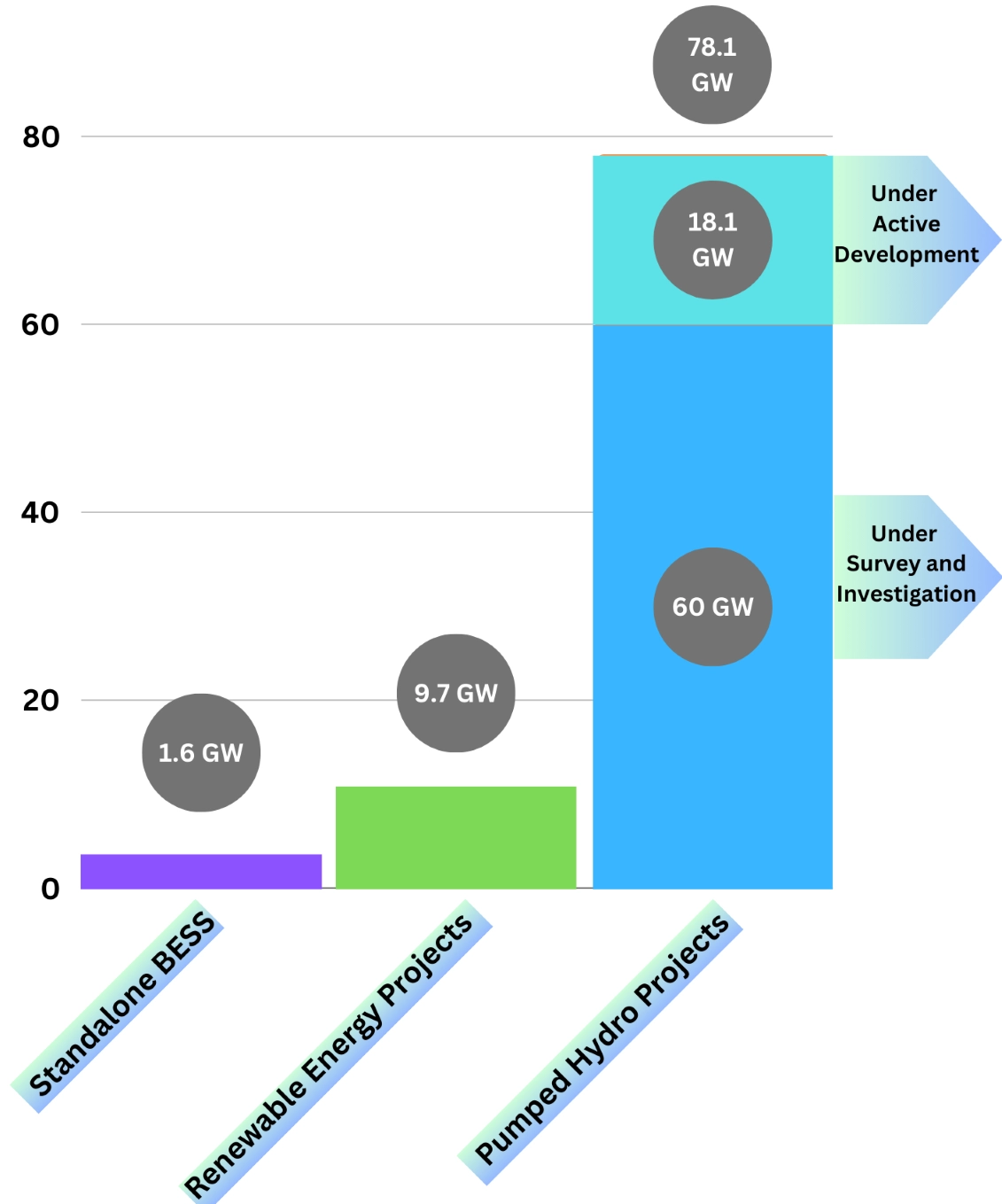July 11 , 2024
Advancements in Battery Energy Storage Systems (BESS) in India
As of March 2024, India has made remarkable improvements in battery energy storage, with the total installed capacity reaching 219.1 MWh. This growth is part of a broader initiative to enhance the country's renewable energy infrastructure and ensure grid stability. A Mercom Report on India’s energy storage landscape projects that by 2027, India will add 1.6 GWh of standalone battery energy storage systems and 9.7 GW of renewable projects integrated with energy storage.

The development landscape in India includes:
-
Standalone BESS: 1.6 GWh are in various stages of development.
-
Renewable Energy Projects: 9.7 GW integrated with energy storage are underway.
-
Pumped Hydro Projects: 78.1 GW are in development, with 60 GW under survey and investigation and 18.1 GW under active development.

Government Initiatives and Policy Measures
The Ministry of New and Renewable Energy (MNRE) has expanded its Approved List of Models and Manufacturers (ALMM), adding 2,674 MW of new solar module capacity. The ALMM now boasts a cumulative capacity of 50,675 MW, with significant contributions from several manufacturers. These additions are crucial in supporting the expanding solar infrastructure and the integration of energy storage systems.
Auction Success: UPNEDA's Solar Projects
The Uttar Pradesh New and Renewable Energy Development Agency (UPNEDA) recently conducted a successful auction for 500 MW of grid-connected rooftop solar projects under the RESCO model, with competitive tariffs discovered across two categories.
Category 1 (25 kW to 200 kW): ₹4.9 (~$0.0587)/kWh
Category 2 (200 kW to 2,000 kW): ₹4.85 (~$0.0581)/kWh
Renewable Energy Integration and Grid Stability
By March 2024, renewable sources contributed 28.9% of India’s electricity capacity. The rapid addition of intermittent renewable energy sources like solar and wind has significantly impacted grid stability. Policy measures such as the deviation settlement mechanism, grid connectivity regulations, and ancillary services regulations are being implemented to ensure efficient renewable integration and grid stability, driving the demand for utility-scale energy storage.
-
Chhattisgarh: Leads in BESS capacity, representing 54.8% of the cumulative installed capacity.
-
Rajasthan: Showing significant growth in standalone BESS capacity due to favorable provisions in the state’s renewable energy policy and annual energy storage obligations through FY30.
Pumped Hydro Storage
India's operational pumped hydro storage capacity stood at 3.3 GW by March 2024, with major installations in Telangana and West Bengal, which account for nearly 76% of the country’s operating capacity.
Energy Storage Market Trajectory
Since the inception of small pilot projects in 2013, India’s cumulative energy storage capacity has now reached 219.1 MWh, with solar PV and BESS systems comprising 90.6% of the installed capacity. In the first quarter of 2024 alone, 120 MWh/40 MW of BESS was added.
57 GW for energy storage projects were floated in tenders, and 11.5 GW of projects were auctioned by March 2024. Tenders for standalone and renewable projects with energy storage totaled 7.4 GW in Q1 2024. These developments underscore India's rapid advancement in energy storage, supported by robust policy frameworks and strategic investments.
Market Insights
Mercom’s comprehensive report provides an in-depth analysis of India’s energy storage landscape, covering key policies, market trends, and future projections. It highlights the challenges and opportunities in the energy storage sector, emphasizing the need for urgent government prioritization to avoid issues faced by other countries with growing intermittent power but insufficient storage capacity. This report serves as a vital resource for top executives in the environmental and renewable energy sectors, offering a clear picture of India’s trajectory in achieving sustainable energy solutions.
Battery Energy Storage Systems (BESS) are critical for integrating renewable energy sources, ensuring grid stability, and optimizing costs. As India continues to expand its renewable energy infrastructure, the advancements in BESS will play a pivotal role in achieving sustainable energy solutions and meeting the country’s Net Zero goals.

